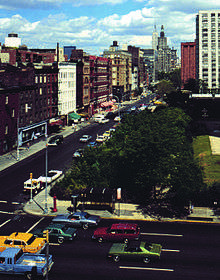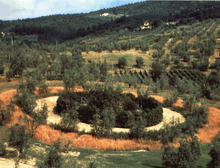Alan Sonfist
| Alan Sonfist | |
|---|---|
 Time Landscape of New York | |
| Born | Bronx, New York City |
| Education | MIT Center for Advanced Visual Studies |
| Known for | Sustainable Art |
| Movement | Environmental Art |
Alan Sonfist is a New York City based American artist most often associated with the Land or Earth Art movement.[1]
He is best known for his "Time Landscape" found on the corner of West Houston Street and LaGuardia Place in New York City's Greenwich Village.[2][3] Proposed in 1965, "Time Landscape" the environmental sculpture took over ten years of careful planning with New York City. It was eventually landmarked by the city. It has often been cited as the first urban forest of its kind. More recently, Sonfist has continued to create artworks within the natural landscape, inaugurating a one-acre (4,000 m²) landscape project titled "The Lost Falcon of Westphalia" on Prince Richard's estate outside Cologne, Germany in 2005.
In Nature: The End of Art, environmentalist Jonathan Carpenter writes that "To review the public sculptures of Alan Sonfist since the 1960s is to witness the reemergence of the socially aware artist. His sculptures reassert the historical role of the artist as an active initiator of ideas within society. Each of his artworks fundamentally redefine what sculpture is, who the artist is, and how art should function for its public."[4]
Life and career
Beginning with his first major commissioned work, “Time Landscapes” in Greenwich Village, NYC, Sonfist received critical acclaim for his innovative use of urban spaces to design havens of nature and green art. His early work in the 1960s and 1970s helped pioneer the burgeoning movement of site-specific sculpture. Today, he continues to promote sustainable energy and strives to raise awareness for global climate change with his international projects. Recently, Sonfist collaborated with Green City Planners in Pori, Finland and Tampa, Florida to create green public spaces.
Sonfist's work derives from an early childhood anxiety towards deforestation. As the Financial Times writes: "One of the pioneers of environmental art, Sonfist’s passion for nature was triggered by his childhood nearby a hemlock forest, which has now died. 'I watched it disappear as people tried to improve upon it,' he tells me sadly. A gentle soul in a pinstriped suit and straw trilby, he believes nature is safest 'when left to be like it is'."[5]

He later attended Hunter College, where he received a Masters in Art. In addition to his studies at Hunter College, he also studied with Gestalt psychologist, Hoyt Sherman at Ohio State University. His research there concerned the language of visual culture and its relationship with human psychology. Later, he went on to pursue a Research Fellowship in visual studies at MIT, Cambridge, MA. After his breakthrough Time Landscape of New York, Sonfist gradually built a reputation as a father of the environmental art movement, presenting a new and unique harmony between ecology and artistry. In 1971, Joshua Taylor, Director of the American Museum of Art, wrote of "Autobiography of Alan Sonfist", a one-person exhibition at the Smithsonian Institution, "[...] some--like Alan Sonfist [...] have reacted to a cosmic consciousness by returning to specific nature in its smallest detail. For art in America, the landscape has meant freedom and expansion, or, when useful, discipline and concentration. But once the artist took possession of his environment, the natural bounty of America was never far from the surface of his art."[6]
His first major publication was on his lecture series at the Metropolitan Museum of Art in 1969. Sonfist edited “Art in the Land,” an anthology on environmental art which was republished in Europe and Asia due to its reception by critics and artists alike. He has been included in multiple major international exhibition catalogs such as the Dokumenta, the Venice Biennale, and the Paris Biennale. Recently, Dr. Robert Rosenblum wrote an introduction to Sonfist’s “Nature: The End of Art” which was distributed by Thames and Hudson, and published by Gil Ori.
Throughout his career, Sonfist has given several keynote speeches for public and private events and organizations such as Pennsylvania State University, the Southern Sculpture Conference, and the American Landscape Association in Miami. He has been a featured speaker in numerous symposiums at major institutions and conferences including the Metropolitan Museum of Art, the Boston Museum of Fine Arts, the Midwest College Association, the U.N. Ecological Conference in São Paulo, Brazil, and the Berlin Ecology Conference. Sonfist has been a featured lecturer at numerous major institutions including the Whitney Museum of Art, the Nelson-Atkins Museum of Art, and the Museum of Contemporary Art of Chicago.
Sonfist has received major awards and grants from private and governmental organizations including the National Endowment for the Arts, the Graham Foundation for Art and Architecture, the Chase Manhattan Bank Foundation, and the U.S. Information Agency. Sonfist’s works are included in many international public collections such as Skulpturen Park Köln (Cologne Sculpture Park) in Germany and Villa Celle, in Tuscany, Italy. His work is also featured in collections of major institutions including Metropolitan Museum of Art, the Dallas Museum of Art, the Princeton University Museum, and the Museum of Modern Art – New York City, The Whitney Museum, and the Ludwig Museum in Aachen, Germany.
Some of his most notable solo exhibitions include “The Autobiography of Alan Sonfist,” at the Boston Museum of Fine Arts, “Alan Sonfist Landscapes” at the Smithsonian American Art Museum, “Trees” at the High Museum in Atlanta, GA, and “Trinity River Project” at the Dallas Museum of Fine Arts. A few of his commissions include, but are not limited to: “Lost Falcon of Westphalia,” commissioned by Prince Richard of Germany, “Time Landscape of Indianapolis,” commissioned by theEiteljorg MuseumofAmerican Indians and Western Art, and “Circles of Time,” on the Gori Estate in Florence, Italy. Sonfist’s current projects include “Ancient Olive Grove,” in Florence and “The Serpentine Mound Protecting the Ancient Seeds,” in Bristol, England.
Current Works
Alan Sonfist’s more recent works include the Circles of Life,[7] in Kansas City, the Disappearing Forest of Germany,[8] in Cologne, and the Endangered Species of New England[9] in Lincoln, Massachusetts, part of the deCordova Sculpture Park and Museum.
Currently, Sonfist is in the production stages for his Island of Paradise—in collaboration with architect Marco Brizzi and ecologist Carlo Scoccianti—in Tuscany, Italy:
Similar in vein to Time Landscape, the island becomes a metaphoric beacon within the swelter and cacophony of cultural production. However, Sonfist's work goes far beyond simple environmental or social commentary. To only observe either Time Landscape or Paradise as a hologram of what once existed before, or as an environmental life-raft within the tumult of urbanization, would represent a failure to see the works as the progressive, evolving landscapes that they are, and the impetus for change that they spark. To look at the dates of Time Landscape (1965-present), one can understand that the work is a dynamic, ever-adapting piece that is subject and meant to change. In the same way, Paradise will grow and transform with the environment into a naturalized configuration, while offering a haven for wildlife and an important stopover on the arduous migration of birds between Europe and Africa each year.[10]
Today, Sonfist continues to promote his message of ecological sustainability and timeless respect for the fragility of nature in each of his green art projects.
“The concept of a year round natural microcosmic forest, which would dontain plants and trees indigenous to pre-colonial New York is fresh and intriguing and is desperately needed for our city.” – Ed Koch, Former New York City Mayor[4]
“After making art of quiet distinction for over 30 years, Alan Sonfist suddenly finds himself close to the spotlight. His concern for the fragility of nature, rather than for its sublimeness or monumentality, makes him a forerunner of the new ecological sensibility.” – Michael Brenson, New York Times[1]
Selected publications
- Sonfist, Alan; Becker, Wolfgang; Rosenblum, Robert (2004), Nature, the end of art: environmental landscapes, Distributed Art Publishers
References
- 1 2 Michael Brenson (13 July 1990), Review/Art; Plaster as a Medium, Not Just an Interim Step, New York Times, retrieved 2011-02-14
- ↑ Ann Landi, Separating the Trees from the Forest, Art News, http://www.artnews.com/2011/08/15/separating-the-trees-from-the-forest/, 8/15/2011
- ↑ Stiles, Kristine; Selz, Peter Howard (1996), Theories and documents of contemporary art: a sourcebook of artists' writings, University of California Press, p. 545, ISBN 978-0-520-20251-1
- 1 2 Sonfist, Alan, Wolfgang Becker, and Robert Rosenblum. Nature, the End of Art: Environmental Landscapes. New York: D.A.P., 2004. Print.
- ↑ https://next.ft.com/content/723dc360-99ab-11e5-9228-87e603d47bdc
- ↑ The American Land. Washington: Smithsonian Exposition, 1979. Print.
- ↑ http://kcai.edu/drupal/artspace/exhibitions/8303/alan-sonfist-circle-life-revisited
- ↑ http://www.artnews.com/2011/08/15/separating-the-trees-from-the-forest/
- ↑ http://www.decordova.org/art/sculpture-park/endangered-species-new-england
- ↑ http://theislandreview.com/content/island-of-paradise
External links
- Official website
- "NATURAL/CULTURAL" Interview with Alan Sonfist by John K. Grande at Green Museum
- Time Landscapes website